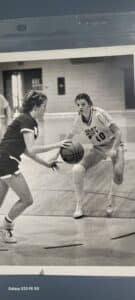From the Rafters
VenuesNow Senior Editor Don Muret’s column runs in the June issue of the magazine.
Tammy Koolbeck has a unique perspective on the growth of women’s sports, especially college basketball, which exploded in popularity the past season, due to the exploits of Iowa’s Caitlin Clark, LSU’s Angel Reese and the entire South Carolina hoops team, which went undefeated at 38-0 and won an NCAA title.
Forty years ago, Koolbeck, VenuWorks’ executive director of Iowa State University’s Stephens Auditorium, played college basketball at Mount Mercy College, a small school in Cedar Rapids, Iowa. Koolbeck, who’s worked in public assembly management since 1995, and was named the 2024 recipient of the IAVM’s Charles A. McElreavy Award for extraordinary contributions to the industry, follows the women’s game closely. She holds season tickets for the ISU women, coached by Bill Fennelly for 30 years.

Tammy Koolbeck stands in front of Stephens Auditorium. (Photos courtesy Tammy Koolbeck)
Back in the day, Fennelly served as Koolbeck’s basketball camp coach when she was a high school junior at Central Lee High School. It sits in the cornfields, tucked in the southeast corner of Iowa, situated six miles from each of the three towns that feed into the institution — Argyle, Donnellson and Montrose, the community where her family lived.
Growing up, Koolbeck played the 6-on-6 game, which was specific to girls and carried its own set of rules separate from the boys, before transitioning to 5-on-5 at the college level. Koolbeck did play 5-on-5 with the boys in pickup games and was recruited to Mount Mercy after getting noticed at a summer basketball camp at Drake University. Clark attended the same camp many years later.
With no athletic scholarships available at the small school level, Koolbeck went to college on an academic grant. Her college career coincided with the transition from the Association of Intercollegiate Women’s Athletics to the NCAA in the early ‘80s. Mount Mercy, which started women’s basketball in 1971, was a member of the National Association of Intercollegiate Athletics, a separate organization for smaller schools.
As a college athlete, she remembers both practicing and playing games at high school gyms in Cedar Rapids before Mount Mercy built the Hennessey Recreation Center that opened in 1985, her senior year. At the old Regis High School, Mount Mercy’s home court, the team had to move gymnastics equipment stored on the court before tipoff. Sometimes, they were forced to practice late at night, pending a gym’s availability.
In other cases, at junior high and elementary schools in Cedar Rapids that were built in the early 20th century, Mount Mercy practiced in gyms that doubled as auditoriums. Koolbeck and her teammates would often have to chase loose balls that bounced off the elevated stage proscenium and into the seats.

Tammy Koolbeck guards an opponent during her college days at Mount Mercy.
For road games, Koolbeck and her teammates came dressed to play, with no locker rooms for women to change from their street clothes.
The crowds for Mount Mercy games ran maybe 200 to 300 people, Koolbeck said, which included the Sisters of Mercy perched in the front row, sporting their black and white gowns and habits. Koolbeck said her high school games attracted more fans for the 6-on-6 game, which was a huge draw among small towns across Iowa.
The state of Iowa has played a historical role in the development of women’s basketball, starting in 1925, with the formation of the Iowa Girls High School Athletic Union.
“We’re the only state to have a separate union from the boys; it’s been like that for almost 100 years,” Koolbeck said. “They oversee 10 sports and it started with basketball. There has always been a platform and a respect for girls athletics because of our history.”
For Koolbeck, she’s seen how times have changed dramatically just over the past year. The NCAA Women’s Final Four championship at Rocket Mortgage FieldHouse peaked at 24 million television viewers on ESPN and ABC, a record number, clobbering the ratings for the Men’s Final Four title game at State Farm Stadium.
The phenomenal ratings were due in part to Clark, a native of suburban Des Moines, Iowa, and her ability to shoot the long ball, an uncanny passing ability, and most important, the strong connection she’s made with young girls, taking time to sign autographs after games.
Iowa’s women sold out all home games the past season at Carver Hawkeye Arena; drew a crowd of 15,000-plus at Spectrum Center in Charlotte for its season opener, an attendance record for a women’s basketball game in North Carolina; and attracted 55,646 fans for an exhibition game against DePaul at Kinnick Stadium, Iowa’s football venue.
Apart from the college level, Clark has already elevated the profile of the WNBA. Thirty-six of the Fever’s 40 games will be shown on television and streaming networks, compared with one game last season.
Ticket sales have spiked across the league and some WNBA teams have moved home games to bigger arenas to accommodate the demand for tickets to see the Fever.
Merchandise sales of Caitlin’s #22 Fever jersey set a record for among pro athletes before Caleb Williams, the NFL’s No. 1 pick by the Chicago Bears, eclipsed the mark a week later.
“She’s the Taylor Swift of women’s sports,” Koolbeck said. “Will Iowa sell out all their games without Caitlin? Probably not, but there will be more people coming than there were before she got there.”







